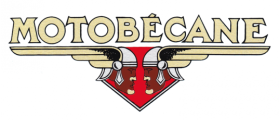

Timeline
1924 Release of the first model: the MB1 175 with belt
1926 Creation of Motoconfort: Release of the 308
1929 Release of the first BMA (Bicyclette à Moteur Auxiliaire): "The B1"
1930 Release of the "B" block Creation of the 4 cylinders B5 & B7 (prototypes)
1934 Release of the S & R series: Arrival of Géo Ham who restyles the range
1945 Release of the D45, popular motorcycle par excellence
1946 Release of the "Z" series
1949 Creation by Charles Benoît & Eric Jaulmes of the Mobylette
1969 Release of the 125 two-stroke
1973 Release of the 350 and 500 three-cylinder
Sources: works by Patrick Barrabès et Eric Jaulmes
motobecane-club-de-france.fr

1925 MB2
175 cm3 2T
Belt drive
With two-speed gearbox and kick starter. This model is equipped with the famous "Wagons" footrests
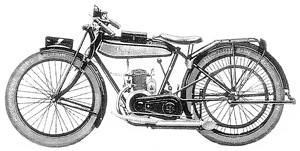
1927 Type D1
175 cm3 2T
175 cm3 2T
The D1 can be considered a basic model. It is the direct heir to the MB1. Its two-speed gearbox drives the rear wheel via a belt.
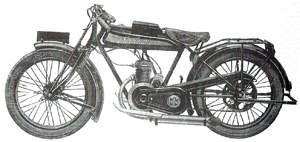
1928 Type D4
175 cm3 2T
Chain drive. Built using 250 type E chassis components.
Motoconfort 308, 1926-1931
The Motoconfort 308cc two-stroke MC1 was introduced in 1926, followed by the 308 Type F in 1928 and F4 / MC7 in 1929, the 308 Type F5 / MC8 in 1930.
The B series two-strokes first appeared in 1930 with the 175cc Type 2. This was followed in 1931 with the B2A which gained a magneto flywheel in 1937 and evolved to the B2A Sport with 3-speed gearbox in 1939.
Motobecane Series B Two-strokes 1930-1939
The compromise: The 250 Type E 1927/1932
Produced for a relatively short period of time, these 250 cm3 Type E at Motobécane and MC6 at Motoconfort, represented a fair compromise between the 175 and the big 308, the top of the range of Pantin's production before the appearance of 4-stroke engine models.
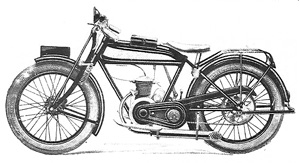
1927 250 Type E / MC6
250 cm3 2T
Strictly identical to the 175 D4 / MC2B, the E-type can be distinguished at first glance by its magneto inclined towards the rear and the six nuts which hold the cylinder head.
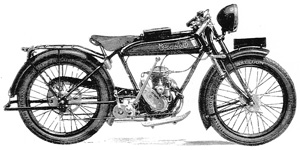
1928 250 Type E
250 cm3 2T
Very little evolution on this model. The initial seat in stamped sheet metal covered with felt and leather is now replaced by a saddle with a leatherette top mounted on sheet springs. The optional installation of a large diameter headlight fixed on the fork and a small red light, powered by a Novi set (sold separately)
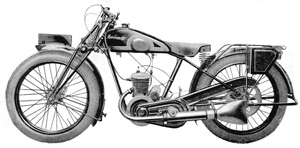
1930 250 Type E
250 cm3 2T
Complete overhaul of the model with the appearance of a new cycle part. Assembly of a parallelogram fork and central spring as well as a saddle tank. The gear lever moves to the right side of the tank, allowing more precise handling than the long lever coming directly out of the box.
BLACKBURNE 4-STROKE ENGINE MODEL 1927/1930
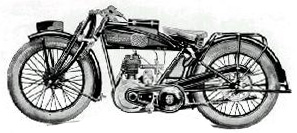
1927 350 Type G
350 cm3 4T
The first generation was equipped with a frame with a tank between tubes. The cycle parts had a "DRUID" type fork, drum brakes, 27 x 4 bead tires, 160 mm flat mudguards, a luggage rack, a TERRY or PLANOR saddle, knee grips and a 2.5l oil tank and were not equipped with lighting as standard.

1928 350 Type G
350 cm3 4T
The second generation released in 1928 received a new frame with saddle tank and a different oil tank but still of the same capacity. The rest of the cycle part has the same equipment, the only changes will be on the accessories (lighting, toolbox, license plate) and this until the end of production (1930).


1929 500 Type H
500 cm3 4T
1929 350 Type K
350 cm3 4T
It was not until 1929 that the rocker arm models arrived. But the MOTOBECANE management did not consider it necessary to give them a type and the catalogue simply states that they are the same models with a more powerful engine.
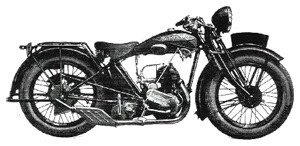
1929 500 Type L
500 cm3 4T
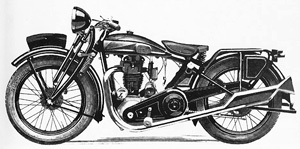
1930 500 Type H2
500 cm3 4T
The H2 or L2 Amateur Competition type with dual exhaust engine with high compression piston, racing cam, IVG Novi magneto, AMAC type 6 carburetor and running on petrol and benzol which allowed this 28.5 hp motorcycle to achieve speeds of 130 to 140 km/h.
250 JAP ENGINE 4 STROKE 1928
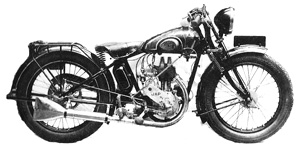
1928 250 Type R2
250 cm3 4T
Motobécane did not have a 250cc 4-stroke engine of its own brand at the time, any more than at Blackburne, the R2 would use the JAP engine.
Single cylinder 4-stroke. Side valves. Single exhaust.
B Series Four-strokes 1930-1939
The "B Bloc" model was the first 4-stroke unit-construction engine manufactured by Motobécane. Available in several displacements including 175, 250, 350 and 500cc, with side valve or overhead valve configuration.
Motobecane B Bloc 4T Series 1930-1939
The B5 (T5) 500 cc and the B7 (T7) 750 cc 1929/1930
3 exceptional prototypes, 4 cylinders (500 with side valves and 750 "overhead" with overhead camshaft) presented in the 1930 catalogue and at the Paris Motor Show the same year.
1929 500 Type T5
500 cm3 4T Sidevalve
TYPE B5. - BLOC MOTEUR. — 4 Cylindres. - Alésage 46. — Course 75.
Transmission par arbre et couple conique. — 3 Vitesses. — Pneus de 27X4. - Réservoir nickel, éclairage et allumage par dynamo et accumulateurs, avertisseur.
TYPE B5. - ENGINE BLOCK. — 4 Cylinders. - Bore 46. — Stroke 75.
Transmission by shaft and bevel gear. — 3 Speeds. — 27X4 tyres. - Nickel tank, lighting and ignition by dynamo and accumulators, horn.
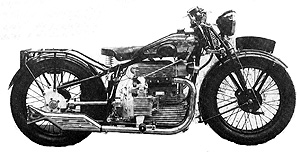
1930 750 Type B7
750 cm3 4T OHV
Presented at the October 1930 Motor Show, the B7 is a 750 with an overhead camshaft controlled by a vertical shaft, visible at the front of the engine.
THE R and S BLOCKS 1933/1947
The "R" block is the first version of the "S" block.
The "R blocks" (or "C" at Motoconfort)
R23
R3c - R33a (250 cc)
R34 (350 cc à soupapes laterales)
R4 - R4c - R44 - R44c (350cc)
R5 - R5c - R55 - R55c (500cc)
"S" blocks (or M at Motoconfort)
S3c (250cc)
S4 - S4c - S4cgs (350cc)
S5 - S5c - S5cgs (500cc)

1933 350 Type R4C
350 cm3 4T OHV
The 1934 R4C 350 single exhaust was catalogued with 3 manual gears. The design of the exhaust caused much ink to flow, but was much copied.
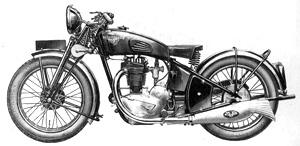
1934 500 Type S5C GS
500 cm3 4T OHV
The very beautiful and very rare 500 "Grand Sport" with "S" block and four valves was only produced in 1934 and 1935. It is called "M5C GS" at Motoconfort and "S5C GS" at Motobecane.
Its cylinder head is that of the "B Grand Sport" engines. Both motorcycles do not yet benefit from the 4-speed gearbox, but are equipped with the foot selector mounted at the front of the block.
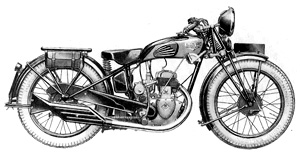
1934 250 Type C3
250 cm3 4T Sidevalve
The Motoconfort type C3: the "S" block also existed with side valves. The "C" presentation was less luxurious: note the sheet metal silencer.
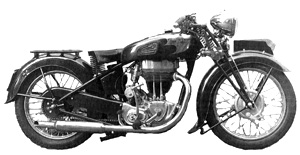
1938 500 Type "Grand Sport Superculasse"
500 cm3 4T OHV
Last model before the war, final descendant of the 300,000 machines built since production began.
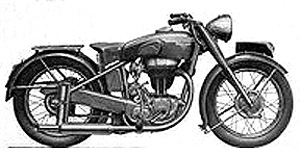
1947 350 Type R46c
350 cm3 4T OHV
The S blocks have disappeared from the catalog, with the exception of this magnificent machine adopting the standards of the time, a sliding rear suspension, telescopic fork, 4-speed gearbox, and the "brown/beige" colors of the Z2c. The whole is imposing and of beautiful workmanship, but will only know a confidential diffusion, the period of "vache maigre" and reconstruction not being favorable to medium cylinders, the less fortunate customer will prefer ... The very sober D45, or the Z2c
1945 D45A
125 cm3 Sidevalve
The D45 appeared in 1945 under the name D45A, had a parallelogram fork and a rigid rear end. Six to seven months of delay were necessary to obtain one. It was followed in 1947 by the D45B, then the 1949 D45S with plunger rear suspension. This model gained telescopic forks in 1951 and became in 1956 the D45S Luxe.
1975 D 55 TT
The TT version of 1975 had larger wheels (21" front, 18" rear), and raised handlebars. The engine was a two-stroke of 49.9cc (39 x 41.8 mm) with premix lubrication and a 5 speed gearbox. It had pedal start, telescopic forks and rear swing arm suspension. Weighing 70 kg, it could achieve 45 km/h.
There was also a D 55 D Sport model in 1974.
Microcars
In the 1950s and 60s the firm built a limited range of microcars and 4-wheeled utility vehicles. These included the KM1 microcar and the KM2 125cc van of 1962.
This page is adapted from an archive of a site by Patrick Barrabès. Further information under French Resources